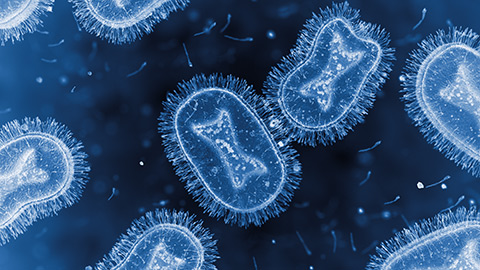
Oh boy, it’s another pandemic!
We’re not done with COVID, not by a long shot (public behavior notwithstanding), and now we have warning signals of another contagious viral infection that is behaving in ways we haven’t seen before—monkeypox.
Before you panic, let’s remember that information is the best defense. So, we’re giving you some background and answering some questions about monkeypox you can use to take appropriate action and to be a source of reliable information for your clients and others.
Monkeypox FAQs:
How many people have it?
How does it spread?
Is it life-threatening?
Is it preventable?
And most of all: how can I keep myself and my clients safe from this infection?
You’ve come to the right place: listen on for these answers and more.
Resources:
Pocket Pathology: /abmp-pocket-pathology-app
ABMP Monkeypox Blog:
“Monkeypox: What Should Massage Therapists Be Watching For?” (2022). Associated Bodywork & Massage Professionals. Available at: /updates/blog-posts/monkeypox-what-should-massage-therapists-be-watching (Accessed: 27 July 2022).
2022 Monkeypox Outbreak Global Map | Monkeypox | Poxvirus | CDC (2022). Available at: https://www.cdc.gov/poxvirus/monkeypox/response/2022/world-map.html (Accessed: 27 July 2022).
CDC (2022). “Monkeypox in the U.S., Centers for Disease Control and Prevention.” Available at: https://www.cdc.gov/poxvirus/monkeypox/symptoms.html (Accessed: 12 July 2022).
Kozlov, M. (2022), “Monkeypox in Africa: The Science the World Ignored.” Nature, 607 (7917): 17–18. Available at: https://doi.org/10.1038/d41586-022-01686-z.
Bajaj, S. (June 24, 2022) “What You Need to Know About the History of Monkeypox.” Smithsonian Magazine. Available at: https://www.smithsonianmag.com/history/what-you-need-to-know-about-the-history-of-monkeypox-180980301/ (Accessed: 12 July 2022).
Monkeypox (May 19, 2022). Available at: https://www.who.int/news-room/fact-sheets/detail/monkeypox (Accessed: 12 July 2022).
Monkeypox in Animals | Monkeypox | Poxvirus | CDC (2022). Available at: https://www.cdc.gov/poxvirus/monkeypox/veterinarian/monkeypox-in-animals.html (Accessed: 12 July 2022).


Books of Discovery:www.booksofdiscovery.com
Advanced-Trainings: Advanced-Trainings.com
About Til Luchau and Advanced-Trainings:
As a Certified Advanced Rolfer™, Til was on the faculty of the Dr. Ida Rolf Institute® for 20 years, where he served as Coordinator and Faculty Chair of the Foundations of Rolfing Structural Integration program.
The author of the Advanced Myofascial Techniques textbook series (which has been translated into 6 languages), his regular Myofascial Techniques and Somatic Edge columns have been featured in Massage & Bodywork magazine since 2009, and (along with Whitney Lowe) he co-hosts the popular Thinking Practitioner Podcast.
He is the Director of Advanced-Trainings.com which since 1985 has offered short, credit-approved professional trainings and certification for manual therapists of all types, in person and online.
Website: Advanced-Trainings.com
Email: info@advanced-trainings.com
Facebook: facebook.com/Advanced.Trainings1/
Instagram: instagram.com/tilluchau
YouTube: youtube.com/user/AdvancedTrainings
0:00:00.1 Speaker 1: Til Luchau is pleased to invite you to two amazing opportunities. Come to Til's popular hands-on sciatica training as it makes its Zoom debut on August 12th. Get a full day of personalized tutoring, camera-on supervision and permanent recordings and CE credit, all at an amazing price. Til's new A-T Subscription gives unlimited access to a growing catalog of over 35 curated advanced myofascial techniques, Feldenkrais and Zoga movement classes for bodyworkers, for as little as $20 per month. Sign up now at advanced-trainings.com.
0:00:48.1 Ruth Werner: Hey, I Have a Client Who listeners, did you know I have a growing library of NCB approved one-hour online self-paced continuing education courses that you can do any time, anywhere? Well, now you know. Current classes include, what's next? COVID-19 Updates For Massage Therapists and A Massage Therapist's Introduction To Pharmacology Part One, and brand new, A Massage Therapist's Introduction To Pharmacology Part Two. Classes are at $20 each and they confer one hour of continuing education credit. Wanna know more? Visit my website at ruthwerner.com and check it out. Be sure to signup for my mailing list so you'll never miss a new class.
[music]
0:01:42.3 RW: Hi and welcome to I Have a Client Who, pathology conversations with Ruth Werner, the podcast where I will discuss your real life stories about clients with conditions that are perplexing or confusing. I am Ruth Werner, author of A Massage Therapist's Guide to Pathology, and I have spent decades studying, writing about and teaching about where massage therapy intersects with diseases and conditions that might limit our clients' health. We almost always have something good to offer even with our most challenged clients, but we need to figure out a way to do that safely, effectively and within our scope of practice. And sometimes, as we have all learned, that is harder than it looks.
0:02:28.2 RW: Today's I Have a Client Who story is not really an I Have a Client Who, it's more like an, I have a state where. And unlike many of these podcasts, this one is extremely time-dependent. I want to emphasize, I'm making this recording in the last week of July, 2022. I started collecting information on this topic about a month ago, and the statistics on this have radically changed since then. And by the time you hear this it will probably be different for you as well. However, the differences are really all about statistics and the number of people affected, not about how the condition itself works, at least so far. If you haven't guessed it, let me go ahead and tell you that today's topic is monkeypox.
0:03:15.4 RW: I decided to choose this topic because yesterday I had a phone call from a friend who works with the state licensing organization and they are looking for some kind of guidance about the safe practice of massage therapy in the context of this viral infection. I also wrote a blog for ABMP about this topic that was published earlier this month, of course, all the statistics in that blog are now completely outdated, but again, the principles of how this infection works have not changed. If you would like to have something in writing or something to share with your clients or other people in your life, I'll be sure and put a link to where you can download that blog with our show notes today. Here we go then, monkeypox; It's a viral infection. It comes from a family called the Orthopoxviruses that mostly affect vertebrates, that's probably why it's called Ortho, which means straight or right. It's in the same family with smallpox and cowpox and a couple that I'd never heard of before now, horsepox and camelpox viruses.
0:04:19.9 RW: One interesting thing that I learned about the monkeypox virus for this podcast is that unlike COVID or HIV, this is a DNA virus, not an RNA virus, and that means it mutates more slowly, and that is very good news for reasons I'll come back to in a bit. The viral infection of monkeypox has been around for generations, of course, but it was first identified in 1958 in monkeys, hence the name. It turns out that it is much more common in rodents than it is in primates and until recently most cases in humans were related to close proximity to infected rats or squirrels or other wild rodents. It was first found in humans in 1970. Monkeypox is endemic to a couple of large areas in the continent of Africa. We've identified two specific types or clades of this virus, which are now called the Central African clade and the West African clade, and it is the West African clade that is now being found literally all over the world in numbers that we have never seen before. And this is kind of good news, because it is the less virulent version of the virus.
0:05:37.6 RW: Monkeypox can be fatal, mainly because it opens the door to life-threatening complications like secondary bacterial infections and encephalitis. In countries where healthcare is hard to come by, like poor countries in Africa that can't afford to pay for life-saving vaccines and treatments, death from complications related to monkeypox happens in anywhere from 2% to 10% of all cases, and this happens most often among young infected children. But for adults who have access to healthcare, monkeypox does not appear to be life-threatening at this time. We have seen no deaths from the worldwide outbreak of monkeypox outside of the African continent. Let's talk a little bit about transmission.
0:06:24.5 RW: Until recently, almost every case of monkeypox was transmitted from animals to humans, probably through bites or scratches or preparing an animal for eating. One of the big differences we're seeing with this large-scale outbreak is the phenomenon of human-to-human transmission, which is relatively new. We know this virus can be spread through sexual activity, but it looks like any kind of intimate contact, including hugs or cuddling or sharing clothing or sharing linens or other kinds of long-term contact can spread the virus between people. There's some indication it can be spread through oral or respiratory droplets and intimate fluids. I wanna emphasize these are droplets, not airborne particles, which is an important distinction to make. Monkeypox does not appear to be transmissible through airborne particles, unlike respiratory viruses like COVID or flu.
0:07:20.0 RW: Another really important thing to emphasize about Monkeypox is that at least at this moment, it does not appear to be contagious unless symptoms are present. Let me say that again. At this moment, asymptomatic viral shedding does not appear to be a factor in monkeypox transmission, and this is excellent news, because that's where we find the information that can help massage therapists to be safe. So what are the signs and symptoms of monkeypox? Well, here's where things get just a little bit muddy. A typical infection, that is before this year, would involve exposure to the virus, a long incubation period of up to two weeks and then a prodrome stage with fever, malaise, muscle aches and pains, and here's the kicker, painful inflamed lymph nodes. And this is one sign that distinguishes monkeypox from smallpox.
0:08:22.6 RW: And then the person breaks out in small painful blisters that might be distributed all over the body, and the blisters are full of fluid that is potentially contagious. The person can transmit this infection at any time from their first fever to the healing of their blisters, and this whole process might last anywhere from three to six weeks. However, we've begun to see some changes in this pattern. One of the things we're seeing now is that people might not show a strong prodrome stage, they may progress directly from incubation to having those painful blisters, and when the infection is transmitted through sexual activity, the blisters may cluster around that area of transmission. Monkeypox is spreading fast. In mid-July we had tracked 10,000 cases outside of African countries and a total of 833 cases in the United States.
0:09:22.6 RW: Now, two weeks later, we're at 19,000 cases around the world, almost double, and 3,600 cases in the United States. We have more than quadrupled our case load. Way to go, USA. Should we be worried about monkeypox? Well, yes and no. I'm not a big fan of being worried for the sake of being worried, but I am a fan of using worry or concern to drive action that improves the situation. And here's the thing, monkeypox doesn't have to be a problem for anyone in African countries or outside of them. We have safe effective vaccines to prevent these infections if we can address equitable access to them. So if this spurs us, and by us I mean first world countries, to take appropriate action in that direction, I'm all for that kind of concern. Remember, we've seen 70 suspected and completely unnecessary deaths in African nations, mostly in kids, probably under-counted, just this year.
0:10:33.0 RW: The other concern that I have is that with this unprecedented worldwide distribution of this infection, it seems possible that even though DNA viruses mutate less readily than RNA viruses, at some point we could be seeing more virulent threatening strains to develop. I'm not predicting doom. Well, okay, maybe I am, a little bit, but what I am doing is expressing some frustration, that with all the experience we've just had and are still having with COVID, it seems like launching a coordinated and purposeful global response to this pandemic wouldn't be out of our reach. I'm happy to say that just yesterday, July 26th, 2022, the World Health Organization has now declared monkeypox a global health emergency, so maybe we'll see some action in that direction. We have a variety of vaccine options for monkeypox, but none of them have been in high production yet.
0:11:36.9 RW: There are no dedicated antivirals for this infection, but some antivirals have found some off-label use for people who get really sick. Right now, most public health efforts in the United States have been focused on isolating infected people and emphasizing prevention, that is avoiding close contact with anyone who might be infected. What does this mean for massage therapists? Well, it means a couple of things. One is that if you have been vaccinated for smallpox, you have some but not complete protection from this very similar virus, but most massage therapists are probably not vaccinated for smallpox, because we stopped doing those vaccines when the virus was virtually eradicated in the wild around the mid-1970s. Does that mean that now you have to go and beat the bushes for a monkeypox vaccine? No. Here's what it means.
0:12:35.0 RW: It means that if a client has a fever with muscle aches and pains and inflamed lymph nodes, you delay the massage, nothing new there. We already do that, right? Right? It also means that if a client has a new rash with painful blisters, you delay the massage. That might be a new thing. The blisters might appear in small areas or around the genitals where we don't see or they might be covered with bandages, so we think this client is safe, but remember the virus may still be communicable through respiratory droplets. So this is a question about rashes or blisters that you might want to add to your intake form, especially if you're working in a place where monkeypox is becoming more common, and that's where we are right now. Monkeypox is spreading fast, it spreads between humans through close contact and respiratory droplets, and while it is painful and inconvenient, it isn't at this point a life-threatening infection for otherwise healthy adults.
0:13:40.2 RW: It isn't communicable before symptoms develop or after they're fully resolved. So mitigating the transmission risk requires a simple accommodation for massage therapists. We delay massage when any symptoms indicative of monkeypox are present. I hope this short discussion has helped you feel a little more grounded about this kind of scary-sounding pandemic. And it is a pandemic, it's a worldwide outbreak of a communicable disease. We need to keep an eye on this one, because we wanna know if it makes a shift toward a more virulent kind of infection or if it changes its presentation. But as I often say, information is the best defense, and I will keep on working to be a good source of information for you and for our profession.
0:14:29.6 RW: Hey everybody, thanks for listening to I Have a Client Who, pathology conversations with Ruth Werner. Remember, you can send me your I Have a Client Who stories to, ihaveaclientwho@abmp.com. That's, ihaveaclientwho, all one word, all lowercase @abmp.com. I can't wait to see what you send me and I'll see you next time.
[music]